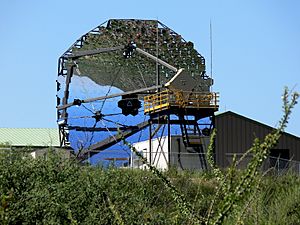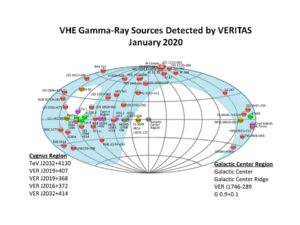VERITAS facts for kids

VERITAS – array of four telescopes
|
|
| Alternative names | Very Energetic Radiation Imaging Telescope Array System |
|---|---|
| Part of | Fred Lawrence Whipple Observatory |
| Location(s) | Arizona |
| Coordinates | 31°40′30″N 110°57′07″W / 31.6751°N 110.952°W |
| Altitude | 1,268 m (4,160 ft) |
| First light | 1 February 2005, April 2007 |
| Telescope style | astronomical observatory gamma-ray telescope |
| Number of telescopes | 4 |
| Diameter | 12 m (39 ft 4 in) |
| Angular resolution | 0.1 degree |
| Collecting area | 100,000 m2 (1,100,000 sq ft) |
| Website | veritas |
VERITAS stands for Very Energetic Radiation Imaging Telescope Array System. It is a special observatory on the ground that uses four large telescopes to study gamma rays from space. Gamma rays are the most powerful type of light in the universe. VERITAS helps scientists learn about extreme events and objects far away.
The observatory is located in southern Arizona, United States, at the Fred Lawrence Whipple Observatory. It works by detecting tiny flashes of light that happen when gamma rays hit Earth's atmosphere.
How VERITAS Works
VERITAS uses four Imaging Atmospheric Cherenkov Telescopes. Each telescope is 12 meters (about 39 feet) wide. They are placed about 100 meters (328 feet) apart. Each telescope has a huge mirror and a very fast camera.
Seeing Gamma Rays
When a gamma ray from space hits Earth's atmosphere, it creates a "particle shower". This shower is a burst of tiny particles. These particles travel faster than light in the air, creating a faint blue flash called Cherenkov light.
VERITAS telescopes are designed to catch these quick flashes. Because there are four telescopes, they can look at the same flash from different angles. This is like seeing something with both your eyes to figure out how far away it is.
Pinpointing the Source
By looking at the flashes from different telescopes, scientists can figure out:
- Where the gamma ray came from in space.
- How much energy the gamma ray had.
This helps them learn about the super powerful events that create these gamma rays.
How VERITAS Filters Data
The telescopes need to tell the difference between gamma ray flashes and other things. These other things could be:
- Flashes from other particles (like cosmic rays).
- Light from stars or the Moon.
VERITAS uses a smart system to filter out unwanted signals. It looks for specific patterns in the light flashes. It also checks if the flash was seen by multiple telescopes at the exact same time. This helps it focus only on gamma rays.
Observing Conditions
Because the Cherenkov light is very dim, VERITAS works best on clear, dark nights. It cannot observe when it's cloudy or rainy. It also avoids very bright moonlight. However, it can still observe when the Moon is somewhat bright.
The observatory usually collects data for about 1,200 hours each year. It takes a break in July and August due to monsoon season.
The Story of VERITAS
VERITAS was built to study very high energy gamma rays. It followed the success of an older telescope called the Whipple 10-meter telescope. The Whipple telescope was the first to clearly find a gamma-ray source, the Crab Nebula, in 1989.
Building the Array
Scientists started planning VERITAS in the 1990s. They wanted to build an array of telescopes. This would allow them to see gamma rays with even more detail and at lower energies.
Construction of VERITAS began in 2003. The first telescope was ready in 2004. By early 2007, all four telescopes were built. The full VERITAS array officially started working in September 2007.
Making it Better
Since 2007, VERITAS has been improved several times.
- In 2009, one telescope was moved to a better spot. This helped the whole array work more efficiently.
- Between 2009 and 2011, the mirrors were improved. The system for filtering signals was also updated.
- In 2012, the cameras were upgraded. This made the telescopes even more sensitive to gamma rays.
Thanks to these upgrades, VERITAS can now find faint gamma-ray sources much faster than before. In 2017, the team celebrated ten years of amazing science with VERITAS.
What VERITAS Studies
VERITAS has a wide range of science goals. It helps us understand the universe in new ways. It also helps physicists search for new particles.
Exploring the Universe
VERITAS helps scientists answer big questions like:
- How are cosmic particles sped up to incredible speeds in our Galaxy and beyond?
- What happens near extreme objects like neutron stars and black holes?
- What is dark matter?
- Is the speed of light always the same, even for super-high energy gamma rays?
VERITAS looks at many different things in space, including:
- Leftovers from exploded stars, called supernova remnants.
- Fast-spinning stars called pulsars.
- Systems with two stars orbiting each other, called binary systems.
- The mysterious gamma-ray source at the center of our Galaxy.
- Very bright centers of other galaxies, called active galactic nuclei.
- Powerful gamma-ray bursts.
Working with Other Observatories
VERITAS often works with other telescopes. These other telescopes might look at different types of light, like X-rays or radio waves. This is called "multi-wavelength" astronomy.
It also works with other types of detectors. For example, it works with telescopes that detect neutrinos or gravitational waves. This is called "multi-messenger" astronomy. By combining different types of information, scientists get a fuller picture of cosmic events.
VERITAS also has a big program to search for dark matter. It looks for gamma rays that might be created when dark matter particles crash into each other.
As of 2020, VERITAS research has led to many scientific papers and 58 Ph.D. degrees. It has found 63 sources of very high energy gamma rays.
Cool Discoveries by VERITAS
Here are some of the exciting things VERITAS has discovered:
- 2008: Found the first "blazar" (a type of active galaxy) that shines brightly in very high energy gamma rays.
- 2009: Discovered the first "starburst galaxy" (a galaxy making lots of new stars) that emits gamma rays. This was important because it showed that normal star-forming processes can create gamma rays.
- 2010: Studied the Jellyfish Nebula, which is a supernova remnant. This helped show that cosmic rays are sped up by these stellar explosions.
- 2011: Found unexpected gamma-ray emission from the Crab Pulsar. This challenged old ideas about how pulsars work.
- 2011: Detected gamma rays from the Tycho supernova remnant. This was from one of the few supernovae seen by people long ago.
- 2013: Pinpointed where gamma rays come from in the powerful jets of active galaxies.
- 2015: Saw gamma rays from a distant quasar (a very bright active galaxy). This showed that the universe is mostly clear for these high-energy photons.
- 2018: Detected gamma rays from a blazar that matched a high-energy neutrino event. This was a big step in multi-messenger astronomy.
- 2019-2020: Used the telescopes to measure the size of stars directly. This showed a new way to use these telescopes.
Citizen Science with VERITAS
VERITAS researchers have also used Citizen Science to help their work. They created a project called "Muon Hunter" on the Zooniverse website. Volunteers looked at images from VERITAS and helped classify them. This helped train computer programs to do the job even better.
Who Works on VERITAS
The VERITAS project is a team effort. It involves about 80 scientists from different universities and research centers. These institutions are located in Canada, Germany, Ireland, and the U.S.
The project is guided by a group called the VERITAS Executive Council. There is also a Spokesperson and a Deputy Spokesperson who lead the science program. These leaders serve for two years and can be re-elected.
The work of VERITAS is supported by funding from several organizations. These include the National Science Foundation and the Smithsonian Institution in the U.S. Also, the Natural Sciences and Engineering Research Council in Canada and the Helmholtz Association in Germany provide support.
See also
- Fermi Gamma-ray Space Telescope
- High Energy Stereoscopic System
- IACT
- List of astronomical observatories
- MAGIC (telescope)




